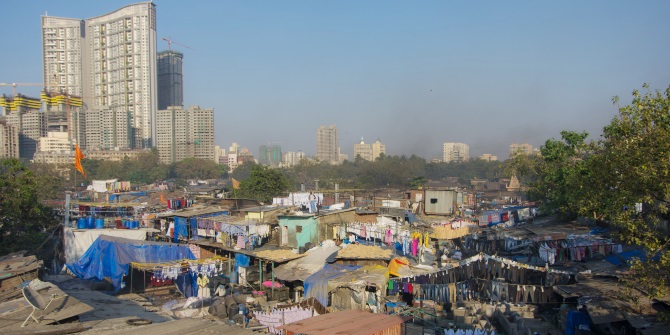What are the impacts of migrant workers’ remittances for Sri Lanka’s economy? Matt Withers (Macquarie University, Australia) argues that temporary labour migration between Sri Lanka and West Asia has resulted in uneven and unsustainable economic returns that warrant greater scrutiny of the presumed relationship between migration and development.
In Sri Lanka, as throughout most of South Asia, low-waged temporary labour migration is a longstanding livelihood practice. Patterns of uneven development, their roots extending far back into colonial and pre-colonial history, have hewn vast fault lines of economic exclusion across the subcontinent and conditioned a common need to migrate seasonally or temporarily in search of work.
As Jan Breman has argued, this survival strategy prevails as a dominant feature of South Asian labour relations. It is perhaps most notably manifest in the international migration of poorly paid domestic workers, construction workers and other, typically menial, forms of labour as an in-situ fix for the developmental aspirations of oil-rich countries in West Asia. Commencing in the 1960s, and involving the temporary migration of millions of workers by the early 1970s, this South to West Asian migration corridor has overseen the largest coherent international movement of labour in history.
These workers continue to endure some of the most deplorable working conditions and rights abuses of the postcolonial era, not only performing ‘3D’ jobs (i.e. the dirty, dangerous and demeaning) routinely earmarked for migrant workers but employed through bonded contracts akin to modern-day slavery. Prevalent claims that temporary labour migration promotes development in countries like Sri Lanka provide an ongoing justification for these exploitative labour practices.
At the heart of contemporary fervour around ‘migration-development’ is the foreign incomes sent home by migrant workers – remittances. Whereas earlier waves of migration-development theory took shape around debates over wage equalisation, human capital formation and trajectories of developmental convergence/divergence, remittances are a relatively new source of academic and policy attention. This is not coincidental.
Until the 1990s, the sum of remittance receipts flowing to developing countries was not particularly significant relative to other capital inflows. By the early 2000s, however, remittances had eclipsed official development assistance (ODA), and even foreign direct investment (FDI), for many developing economies. Taken in aggregate, remittances appear to entail a large transfer of capital that should not only benefit individual migrants and their households, but yield spillover effects that catalyse development outcomes for local communities and national economies. The intuitive sway of this logic – that income transfers promote development – has left even those critical of temporary labour migration schemes acknowledging an implicit developmental benefit to remittances.
It is this characterisation of remittances as a form of developmental capital that underscores the World Bank’s now-ubiquitous ‘triple win’ thesis, used to promote the temporary migration of low-waged workers from countries throughout the Global South. The triple win thesis posits that temporary labour migration is mutually beneficial for migrant workers, the (developing) countries they originate from and the (developed) countries they travel to – i.e. a ‘win-win-win’ scenario. Migrant workers are expected to benefit from improved wages, the development of skills, and opportunities to invest their remittances upon returning home; countries of origin are expected to benefit from a net increase in human capital via ‘brain circulation’ and the accumulation of foreign exchange earnings from remittance receipts; while countries of destination are expected to benefit from access to ‘flexible’ labour markets.
While the ‘win’ for migrant-receiving economies is readily apparent (i.e. access to a global reserve army of cheap and exploitable labour), the benefits associated with corresponding remittance inflows are under-theorised and empirically unsubstantiated. Much like the concept of microfinance, remittance-led development is a popular narrative in the genre of ‘self-help development’, in which credit constraints are positioned as the principal impediment to a latent groundswell of entrepreneurship that, unfettered, would spearhead economic growth. There is conspicuous disregard for state-driven development and the accompanying rungs of public services, welfare, job creation, protectionism and industrial policy that have historically comprised the ladder to capitalist development. Instead, cast as individual agents of development, migrants are held accountable for improving their own circumstances by ‘selling’ their labour power abroad and subsequently ‘investing’ the residual component of their remitted wages.
Although the World Bank continues to assert that remittances will alleviate poverty, spur migrant entrepreneurship, create spillover effects for local communities and improve the creditworthiness of migrant-sending countries, even IMF economists have warned of the null hypothesis between remittances and economic growth. More damning is the lack of a readily identifiable migration-development success story. At an abstract level, this is hardly surprising. From any understanding of ‘development’ as a relative measure of prosperity between countries, the triple win is an intuitively absurd proposition, analogous to expecting the wealth of labour to converge upon that of capital through the employment relationship itself. A more systematic analysis, however, requires mapping the implications of remittance transfers at multiple scales – from recipient households and local communities, to Sri Lanka’s national economy and global patterns of capital accumulation.
There is a tendency to think of remittances only in aggregate: as billions of dollars flowing from richer to poorer countries. But remittance capital is distinct from other forms of developmental capital, being simultaneously comprised of multiple private income transfers and the combined foreign exchange earnings they amass, both of which have important macroeconomic consequences. In Sri Lanka, where migrant workers are equivalent to roughly 25 percent of the domestic workforce, these are not trivial outcomes.
On the one hand, the lifecycles of migrant income transfers can be highly complex. Remittances are only the portion of migrant incomes not spent during foreign employment or deducted for living expenses; they incur steep transfer fees, are frequently prioritised to repay loans taken to cover recruitment costs, and are then typically spent on other liabilities and household consumption needs before any residual amount could possibly be allocated for ‘investment’ purposes. Interviews with returned migrant workers in Sri Lanka indicated that remaining remittances were rarely spent on business activities, but used for housing, education, healthcare, consumer durables and jewellery. This fragmented expenditure of remittances at the household level can reinforce existing macroeconomic imbalances – with non-subsistence expenditures often spilling over into demand for imported goods.
On the other hand, the total foreign exchange receipts of these transfers provide an annual US$7 billion buffer to Sri Lanka’s current account, helping to maintain currency stability amid a persistent trade deficit. Maintaining a strong rupee has certain advantages: it helps to finance imports and repay external debt accrued through developmental loans. In a sense, much of Sri Lanka’s post-war development has been financed by migrant workers’ remittances. Yet, crucially, the Dutch Disease effects remittances tend to produce place additional constraints on how these developmental loans are spent. Sri Lanka’s already anaemic export sector has collapsed astride increasing remittance inflows – dwindling from 35 percent of GDP in 2000 to just 13 percent in 2017 – with investment moving from the tradeable to the non-tradeable sector. Hamstrung by an overvalued currency, development spending has not been earmarked for industrialisation or export diversification, but instead used to finance a variety of pork barrel infrastructural projects built with Chinese loans and labour (highlights of which include a loss-operating port and the world’s emptiest international airport). There is an aspect of path dependency here too. With ever-increasing remittances (and therefore migrant departures) needed to maintain the currency and repay existing loan obligations, local employment generation threatens to kill the proverbial cash cow.
Despite extending the short-term viability of its own uneven development and keeping poor households above the poverty line, Sri Lanka’s dependency on temporary labour migration and remittances is entrenching long-term underdevelopment by neglecting local industry in favour of routing labour power and effective demand to other regions of the world economy. Although framed as mutually beneficial, the relative distribution of ‘wins’ associated with temporary labour migration seem decisively skewed towards the already developed. With the ladder of industrial development receding from view, Sri Lanka is left to confront a vulnerable overdependence on remittances, as an entirely exogenous source of developmental capital that is precariously tied to the continued good fortune of West Asia’s oil-economies. With similar ‘remittance economies’ emerging throughout the Global South, serious questions must be asked of the dominant migration-development policy discourse, particularly the continued espousal of migrant entrepreneurship and remittance-driven development without the threshold of evidence needed to lend veracity to such claims.
The triple win is essentially an argument that the ends of temporary labour migration justify its means; in the context of the South Asia to West Asia migration corridor, in which the most egregious violations of human and labour rights are entirely commonplace, this justification falls alarmingly short.
This article gives the views of the author and not the position of South Asia @ LSE blog, nor of the London School of Economics. Please read our comments policy before posting. Featured image: Money Tower. Credit: kschneider2991, Pixabay.
This piece was originally published on the University of Sydney’s Progress on Political Economy blog.






